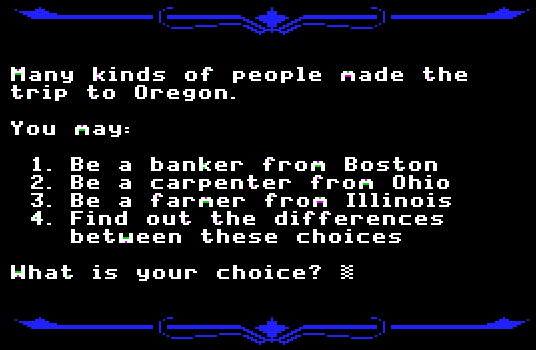The Oregon Trail
Originally released in the 1970s, the survival, choose-your-own-adventure game simultaneously educated and entertained millions of elementary schoolers and has now become a cultural icon. In 2016, the game was inducted into the World Video Game Hall of Fame, and deemed by Time Magazine as the 9th Best Video Game of All Time.

Background
The game itself has sold more than 65 million copies and has been so distinctive in its players’ memories that people like
Anna Glarvey claim allegiance to the “Oregon Trail Generation” rather than the Generation X or Millennial groups.
The game itself is surprisingly well designed from an interactions standpoint. In the age of Apple II and MS-DOS computers, the few consumers that had computers had 8-bit color, rudimentary sound, and limited processing power. The whole idea of game design, frameworks like the Mechanics-Dynamics-Aesthetics (MDA), and potential market audiences were lands to be pioneered in their own rights. The Oregon Trail came out alongside games like Atari’s Pong and set the standard for education electronics to come.

Gameplay
The start of the game greets the user with a menu screen displaying the options: jump right into the game, learn more, see the high scores, and sound toggle. This
entry point clearly displays options that the user can take while
nudging the player to simply start, (especially if you read the somewhat patronizing ‘learn-more’ option). This first impression in all of its 8-bit glory was actually fairly well developed as it minimized any barriers to progressing in, provided the player a
frame to reference in regards to gameplay before even starting, and included lures to draw the player in (as if any elementary schooler would opt out of playing a video game during class-time). Selecting the start option brings the user into a sequence of options and customization in
progressive disclosure rather than in a spontaneous dump of choices. This helps the decision process by reducing the time needed to make a choice (
Hick’s Law). The first option is choosing the player’s profession and starting money – essentially a form of
control by determining how easy the rest of the gameplay will be. 💸
This slideshow requires JavaScript.
Enticing Game Aspects
One way the game succeeds is in giving a space and fulfillment with each distinct type of player as proposed by Richard
Bartle. For the
explorers trying to check out every aspect of the game, there are cutscenes to evoke situations, towns to investigate, and options to test and ponder; For the
achievers trying to succeed in the game, the lofty end goal of traveling all the way to Oregon is facilitated with the display of “next landmark” miles remaining, and constant access to a map for progress markers, as well as an inventory quantifying all items that the player seeks to acquire for survival; For the
killers who thrive on competition and anarchy, there’s a scoring system with a leaderboard giving winners boasting rights, and the game even features a hunting mini-game where some might try to see how many pounds of meat they can comparatively shoot down even when there is a maximum haul of 100 or 200 pounds; For the
socializers who thrive on interactions in and out of the game, the leaderboard provides a place of discussion and the choose-your-own-path deviations create mini
ingroups that no doubt manifested themselves in heated elementary classroom discussions. By appealing to all kinds of players and building meaningful interactions,
The Oregon Trail greatly elevated its gameplay from a moment-in-time entertainment device to an entity of lasting impression.
“It’s hard to think of another game that endured for so long and yet has still been so successful. For generations of computer users, it was their introduction to gaming, and to computer use itself.”
– Jon-Paul C. Dyson,
Director of the International Center for the History of Electronic Games

However, if you were like me and never had the satisfaction of reaching the end or even the opportunity to play it, the Internet Archive has a licensed stream where you can bask in its cultural significance and ahead-of-its-time design.
1: Featured Image by Ethan Barnowsky


